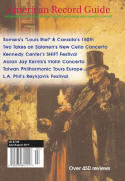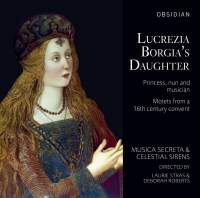Texte paru dans: / Appeared in: |
|
|
Outil de traduction ~ (Très approximatif) |
|
|
Reviewer: Catherine
Moore Though withdrawn from the world, cloistered nuns in Italy not only composed and performed some of the finest and most progressive music of their time, but they also spread it far beyond the convent walls. Simply put, “in the 16th Century the sound of [polyphonic] convent music was the sound of the Renaissance city”. The nuns’ fame was widespread and they drew audiences from far and wide, but nuns were not allowed to take credit as individual composers. Nevertheless, there is sufficient evidence to link this music to the Corpus Domini convent in Ferrara and to its abbess, Sister Leonora D’Este (1515-75). The daughter of Lucrezia Borgia, Leonora was born a princess (her mother died in childbirth
when Leonora was 4) and grew
up to be a nun and a musician, the latter vocation being one she shared with
other family members such as her aunt Isabella D’Este. The Musica Secreta ensemble, led by Deborah Roberts (well known for her Tallis Scholars work), has championed music by and for women composers for many years. Deborah Roberts also formed Celestial Sirens in 2003 as “a select non-professional choir of female singers based in Southern England”. Together these two vocal ensembles bring together women aged from their teens to their 60s, and they are the ideal interpreters of these 16 motets from a 1543 collection. In the booklet essay we learn that this volume is “the earliest published polyphony we can be certain was intended for nuns”. The music is composed in voci pari style, which means that the five voice-parts are for similar ranges such as would be found in a single-sex religious house (either for men or women). In these interpretations, organ and bass viol complement the voices from time to time and extend the range as needed.
Texts are set with color and
imagination, and the composer was not averse to using dissonance to
underline references to fears of plague (as in the motet ‘O Beate Christi
Confessor’, honoring St Roch) and church bells pealing across the city
celebrating Easter Day (‘Angelus Domini Descendit’, one of the motets that
also has references to the important role devout women play). These excellent performances fuse virtuosic skill and devotional ardor to capture all the prayerfulness, reflection, and ecstasy that abound in this fine music. Notes, bios, texts, translations. | |
|
Support us financially by purchasing this disc from eiher one of these
suppliers. Un achat via l'un ou l'autre des fournisseurs proposés contribue à défrayer les coûts d'exploitation |
|
|
|
|
|
Cliquez l'un ou l'autre
bouton pour découvrir bien d'autres critiques de CD |
|




